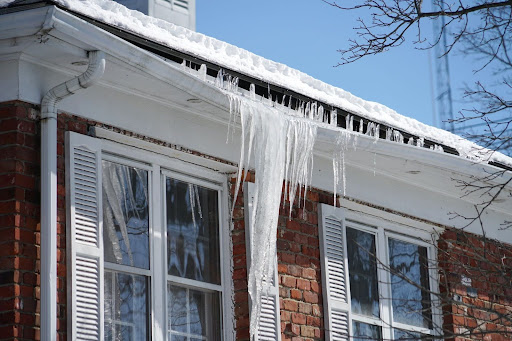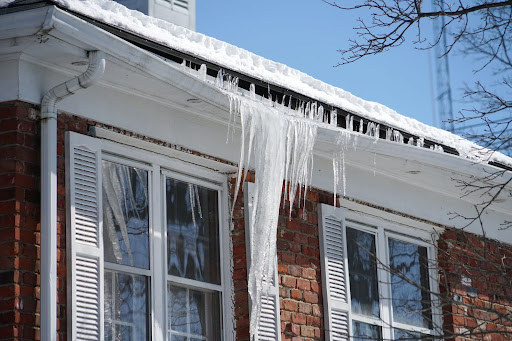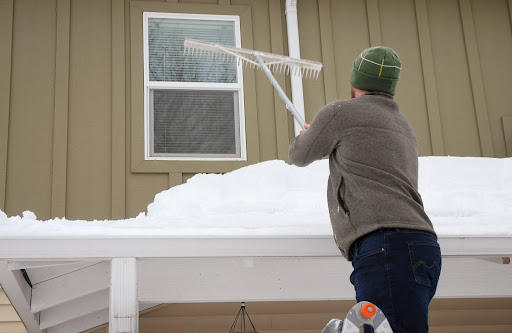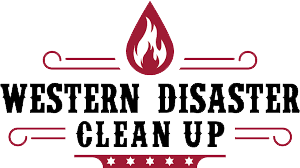As winter brings its snowy charm and invites us to enjoy the coziness of our homes, there’s a lesser-known adversary that quietly emerges — the ice dam.
No, we’re not referring to those picturesque formations on distant rivers. We’re diving into the world of ice dams that take shape right on your roof. These seemingly innocent yet potentially destructive formations wreak havoc on your property during the colder months.
Understanding the nuances of ice dams is not only useful; it’s essential. Our mission? To equip you with the knowledge and strategies needed to shield your home from the perils they pose.
So, as winter’s embrace tightens, join us in unraveling the mysteries of ice dams and ensuring a season that’s warm, dry, and secure for your cherished abode.

What are ice dams, and how do they form?
An ice dam is a ridge of ice that forms at the edge of a roof, typically along the eaves or overhanging sections. It’s called an “ice dam” because, much like a dam on a river, it obstructs the natural flow of water. Ice dams are problematic during the winter months, particularly in regions with cold climates and heavy snowfall.
The formation of an ice dam is a multistep process that is closely tied to the temperature variations on a roof. It all usually starts with variations in roof temperature. The upper portion of the roof, often closer to the ridge or peak, tends to be warmer than the lower sections near the eaves. This temperature difference occurs due to heat escaping from the interior of the house, insufficient insulation, or warm air rising from the living spaces below.
When snow falls on the roof, it accumulates evenly across the surface. The entire roof is cold enough to keep the snow frozen. On sunny winter days, the sun’s heat penetrates the roof’s surface, warming the upper portion. This causes the snow on the warmer upper roof to melt, creating a flow of water.
As this water flows down the roof towards the eaves, it reaches the colder, unheated section. Here, the freezing outdoor temperatures cause the water to refreeze. The repeated melting and refreezing cycle gradually builds up a layer of ice along the eaves. This ice accumulation forms the dam, which grow larger with each cycle.
As more snow melts on the upper, warmer part of the roof, the water flows down but is blocked by the ice dam at the eaves. This trapped water has nowhere to go but backward, under the shingles and into the roof structure.
Several factors increase the likelihood of ice dam formation:
- Inadequate insulation: Poor insulation in your attic allows warm indoor air to escape into the attic space, heating the roof from beneath. This causes snow to melt unevenly and contribute to ice dam formation.
- Roof pitch: The pitch or slope of your roof affects the risk of ice dams. Roofs with shallower pitches are more susceptible because they have less distance for the melted snow to travel before freezing at the eaves.
- Snow accumulation: Heavy snowfall provides ample material for ice dams to form. Deep layers of snow insulate the roof, trapping heat and promoting melting.
- Temperature fluctuations: Rapid temperature changes, common in winter, accelerate the melting and refreezing process, exacerbating ice dam formation.
The dangers of ice dams
Ice dams have the potential to wreak havoc on your home. But what kind of chaos do they unleash? Well, let’s take a closer look at the chaos they cause.
First up, there is structural damage. The weight of the ice dam is like an elephant sitting on the roof’s edge. It stresses the roof’s framing and affects its structural integrity. As if that weren’t enough, the freeze-thaw cycle plays a sneaky game with the roofing materials, leading to shingle damage and their slow but sure deterioration.
Then there’s the gutter system, which becomes the battleground’s front line. The weight of the ice makes gutters sag or even break free from the fascia board. As the ice dams form and melt, water flows over the gutters’ edge, causing mayhem. Soffits, fascia, and siding start taking hits, compromising not only the gutters but the look of your home.
Roof integrity is another casualty. Water seeping beneath shingles and then freezing lifts and damages them. Over time, this leads to leaks, turning your attic, walls, and ceilings into potential war zones. A soggy home isn’t something anyone wants.
Inside, it’s a whole different battlefield. Water from melting ice dams makes its way in, creating leaks and causing havoc with your walls, ceilings, and insulation. When left unchecked, this moisture turns your home into a breeding ground for mold and mildew, not the roommates you’d want.
Lastly, energy efficiency takes a hit. Ice dams mess with your roof, making it less efficient at keeping the cold out and the warm in. This means your heating system has to work extra hard to keep you comfy. The result? Higher energy bills.
While ice dams might look like a minor inconvenience, they’re like little time bombs, ticking away and causing trouble all around your home. Understanding the risks is the first step in safeguarding your fortress. Ready to tackle these icy foes head-on?

Recognizing the warning signs
Spotting ice dams early saves your home from significant damage. Here’s how to identify them:
- Icicles: The most apparent sign is the presence of icicles hanging from your roof’s edge. While icicles themselves may look charming, they indicate that ice dams are forming.
- Ice buildup: Look for thick layers of ice at the roof’s edge or in your gutters. This ice buildup is a clear indication of ice dams.
- Water stains: Inside your home, check for water stains or wet spots on your ceilings and walls, especially near the roofline. These stains often mean that water is infiltrating your home due to ice dams.
- Dripping water: If you notice water dripping or trickling down from your roof’s edge during cold weather, it’s a sign that ice dams are forcing water into your living spaces.
Ice dams invite water infiltration, leading to a world of interior trouble. Ceilings and walls might not hold up well, paint could start peeling, and let’s not forget, the costs of fixing all this damage can pile up quicker than you’d like.
Preventing ice dams
Preventing ice dams is the key to avoiding winter water damage both inside and outside your home. Here are some proactive steps to take:
- Maintain a cold roof: Keeping your roof cold is essential. This is achieved by ensuring proper insulation in your attic and improving ventilation. A cold roof discourages snow from melting and refreezing at the eaves, where ice dams tend to form.
- Seal air leaks: Inspect your attic for any gaps, cracks, or openings that could allow warm indoor air to escape and heat your roof. Seal these leaks with caulk or insulation to maintain a consistent roof temperature.
- Clear debris: Keep your roof clean by removing leaves, sticks, and any debris that trap heat and create hotspots, which lead to ice dam formation.
- Install roof and gutter heating cables: These cables help melt snow and ice along your roof’s edge, preventing ice dams from developing.
Proper attic insulation and ventilation
When it comes to insulation, make sure your attic is decked out with enough of it, especially on the attic floor. This insulation is your trusty shield, preventing warm air from sneaking up into the attic and heating the roof where ice dams love to form.
And speaking of airflow, ventilation is the name of the game. You want that brisk outdoor air to have a smooth journey through the attic, keeping the temperature steady. So, consider installing soffit and ridge vents; they ensure this airflow keeps your roof cool and ice dam-free.
Strategies for safely removing ice dams
If ice dams have already formed, it’s crucial to remove them safely. However, the last thing you want to do is cause more damage to your home or yourself in the process of removing the ice dams. Here are some ways to do so safely and effectively.

Use a roof rake
A roof rake with a long handle can be used to remove snow from your roof, reducing the risk of ice dam formation. Start by safely clearing accumulated snow from your roof. Begin at the edge and work your way up, making sure to avoid any aggressive scraping that could harm your shingles.
Apply calcium chloride
Next, create shallow channels through the ice dam to facilitate the melting of ice and snow runoff. You can achieve this by using a calcium chloride-filled sock or pantyhose. Place these channels perpendicular to the dam, allowing them to melt and drain effectively.
Lastly, verify that your gutter downspouts are unblocked to enable proper drainage. If they’re obstructed by ice, use calcium chloride to melt the ice and clear the downspouts.
Calling professionals for ice dam removal
If you’re dealing with extensive ice dams or simply uncomfortable handling them yourself, it’s a wise decision to call professionals for removal. These experts will thoroughly assess the situation, utilizing specialized equipment and techniques to safely and effectively eliminate ice dams.
By entrusting the task to professionals, you minimize the risk of causing further harm to your roof or gutters during the removal process. Additionally, they may offer valuable recommendations for implementing long-term solutions to prevent future occurrences of ice dams, ensuring the protection of your home in the seasons to come.
Western Disaster Clean Up — your winter warriors
Understanding and preventing ice dams is paramount in safeguarding your home from the perils of winter water damage. By recognizing the warning signs, taking proactive measures, and promptly addressing existing ice dams, you’ll be able to ensure a dry and worry-free winter season.
However, should you ever find yourself in need of expert assistance in dealing with the aftermath of ice dams or any other winter-related disasters, reach out to Western Disaster Clean Up.
With our professional expertise and unwavering commitment to restoring your home to its former glory, we are your trusted partner in times of crisis. We’re available 24/7 to help. Simply call 385-832-6470.

